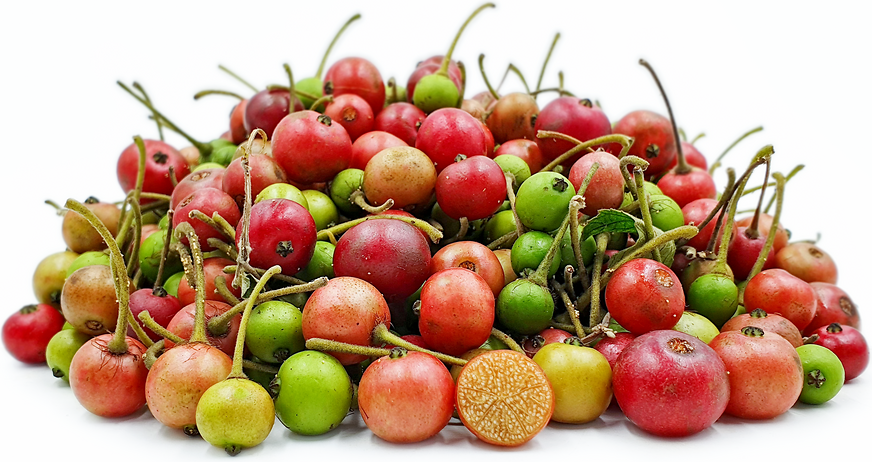


Jamaica Cherries
Estimated Inventory, lb : 0
Description/Taste
Jamaica cherries are small in size, averaging 2-5 centimeters in diameter and are round to ovate in shape with slender, slightly curved stems. The skin transforms from green when young to yellow and red when mature and is smooth, shiny, tender, and thin. Underneath the skin, the flesh is aqueous, yellow-red to translucent, and contains many tiny, yellow seeds dispersed throughout the entire fruit. Jamaica cherries have a crisp, soft, juicy, and crunchy texture with a musky, very sweet, and mildly tart flavor.
Seasons/Availability
Jamaica cherries are available year-round in tropical climates.
Current Facts
Jamaica cherries, botanically classified as Muntingia calabura, are the small fruits found on a fast-growing evergreen tree that can reach up to ten meters in height and belongs to the Muntingiaceae family. Also known as the Singapore cherry, Ceri, Ceri Kampung, Strawberry tree, and many other local nicknames, Jamaica cherries are not commercially cultivated but are well-known locally in tropical regions around the world. Despite their name, Jamaica cherries are not true cherries but are given this name due to their similarity in appearance. Jamaica cherries are favored for their sweet-tart flavor and are commonly consumed fresh, out-of-hand as a crunchy, juicy snack.
Nutritional Value
Jamaica cherries are an excellent source of vitamin C and also contain some calcium, iron, fiber, and phosphorus.
Applications
Jamaica cherries are popularly consumed raw and are a favorite snack fruit for their bite-sized nature and sweet, crunchy flesh. The fruits can be mixed into mint tea for added flavor, or they can be cooked into jams, preserves, and sauces. Jamaica cherries can also be used in desserts and are layered in tarts or topped over ice cream and cakes, or they can be tossed into green salads. In addition to the fruits, the leaves are also edible and can be infused to make a tea that is used as a medicinal drink in some traditional medicines. Jamaica cherries are highly perishable and will only keep for a few days when stored in the refrigerator.
Ethnic/Cultural Info
In Southeast Asia, Jamaica cherries are not cultivated on a large scale and are often grown alongside city streets, in parking lots, common parks, and gardens for added shade. The prolific trees produce an abundant amount of fruit, and it is common for locals to pick the fruits off of the trees found in the city for a sweet treat. Jamaica cherries are mainly consumed fresh, but the fruits and leaves are also used in traditional medicine to help relieve headaches and pain, reduce inflammation, and protect the overall health of the body. In addition to providing high nutritional properties to humans, the fruits are also consumed by bats and birds. These animals consume the fruits and then expel the many small seeds through excrement, spreading the range of the tree to grow in new places. In Brazil, the trees are planted along the shoreline to lure fish with the fruits. When the fish arrive to eat the fruit, they are easily caught by fisherman.
Geography/History
Jamaica cherries are native to tropical regions of the Caribbean, Central America, and South America and have been growing wild since ancient times. The trees were then introduced to Asia and Southeast Asia via trade routes and explorers where they became naturalized in many of the countries. Today Jamaica cherries can be found in Thailand, Vietnam, India, Cambodia, China, Indonesia, Japan, the Philippines, South America, Cuba, Costa Rica, Mexico, the Dominican Republic, Jamaica, Haiti, and Hawaii.




